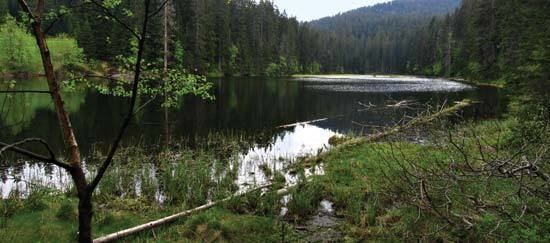 | ||
The Bohemian Massif; Czech: Česká vysočina or Český masiv; is in the geology of Central Europe a large massif stretching over central Czech Republic, eastern Germany, southern Poland and northern Austria. It is surrounded by four ranges: the Ore Mountains (Krušné hory, or Erzgebirge) in the northwest, the Sudetes (for example Krkonoše, Hrubý Jeseník) in the northeast, the Bohemian-Moravian Highlands (Českomoravská vrchovina) in the southeast, and the Bohemian Forest (Šumava) in the southwest. The massif encompasses a number of mittelgebirges and consists of crystalline rocks, which are older than the Permian (more than 300 million years old) and therefore deformed during the Variscan Orogeny.
Contents
Map of Bohemian Massif, 289 12 Sadsk%C3%A1, Czechia
Geography
The landscapes in the Bohemian Massif are mostly dominated by rolling hills. North of the river Danube the topography is characterized by gentle valleys and broad, flat ridges and hilltops. The highest peaks on the Czech-Austrian borderline are Plechý-Plöckenstein (1,338 m) and Sternstein (1,125 m). The bedrock of acid gneiss and granite is weathered to brown soil (cambisols). In flat areas and valleys the groundwater had more influence on soil formation; in such places gley soils may be found too.
As in the other Variscan mittelgebirges of Central Europe, the valleys are more irregular and less pronounced as in the relatively young fold and thrust belt of the Alps. The plateaus are orographically more similar in morphology. Water gaps in the Bohemian Massif are the Wachau, the Strudengau and the valley of the Danube from Vilshofen over Passau and the Schlögener Schlinge till Aschach.
Tectonic subdivision
The internal tectonic structure of the Bohemian Massif was formed during the Variscan Orogeny. The Variscan Orogeny was a phase of mountain building and accretion of terranes that resulted from the closing of the Rheic Ocean when the two paleocontinents Gondwana (in the south) and Laurussia (in the north) collided. Most of the Bohemian Massif is often supposed to belong to a terrane called Cadomia or Armorica, which also included the terranes of the Armorican Massif in western France. This supposedly formed a microcontinent that became sandwiched between the large continental masses north and south. The result of the Variscan Orogeny was that almost all continental mass became united in a supercontinent called Pangaea. From the Permian period onward the Variscan mountain belt eroded and became partly covered by younger sediments, with the exception of Variscan massifs like the Bohemian Massif.
The basement rocks and terranes of the Bohemian Massif are tectonically part of three main structural zones, which differ in metamorphic degrees, lithologies and tectonic styles. This tectonic subdivision was formed during the Variscan Orogeny.
